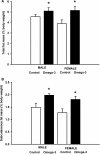Maternal omega-3 supplementation increases fat mass in male and female rat offspring
- PMID: 22303344
- PMCID: PMC3268601
- DOI: 10.3389/fgene.2011.00048
Maternal omega-3 supplementation increases fat mass in male and female rat offspring
Abstract
Adipogenesis and lipogenesis are highly sensitive to the nutritional environment in utero and in early postnatal life. Omega-3 long chain polyunsaturated fatty acids (LCPUFA) inhibit adipogenesis and lipogenesis in adult rats, however it is not known whether supplementing the maternal diet with omega-3 LCPUFA results in reduced fat deposition in the offspring. Female Albino Wistar rats were fed either a standard chow (Control, n = 10) or chow designed to provide ∼15 mg/kg/day of omega-3 LCPUFA, chiefly as docosahexaenoic acid (DHA), throughout pregnancy and lactation (Omega-3, n = 11) and all pups were weaned onto a commercial rat chow. Blood and tissues were collected from pups at 3 and 6 weeks of age and weights of visceral and subcutaneous fat depots recorded. The expression of adipogenic and lipogenic genes in the subcutaneous and visceral fat depots were determined using quantitative real time reverse transcription-PCR. Birth weight and postnatal growth were not different between groups. At 6 weeks of age, total percentage body fat was significantly increased in both male (5.09 ± 0.32% vs. 4.56 ± 0.2%, P < 0.04) and female (5.15 ± 0.37% vs. 3.89 ± 0.36%, P < 0.04) offspring of omega-3 dams compared to controls. The omega-3 LCPUFA content of erythrocyte phospholipids (as a% of total fatty acids) was higher in omega-3 offspring (6.7 ± 0.2% vs. 5.6 ± 0.2%, P < 0.001). There was no effect of maternal omega-3 LCPUFA supplementation on the expression of adipogenic or lipogenic genes in the offspring in either the visceral or subcutaneous fat depots. We have therefore established that an omega-3 rich environment during pregnancy and lactation in a rodent model increases fat accumulation in both male and female offspring, particularly in subcutaneous depots, but that this effect is not mediated via upregulation adipogenic/lipogenic gene transcription. These data suggest that maternal n-3 LCPUFA supplementation during pregnancy/lactation may not be an effective strategy for reducing fat deposition in the offspring.
Keywords: adipose tissue; maternal nutrition; omega-3.
Figures


Similar articles
-
Omega-6:Omega-3 Fatty Acid Ratio and Total Fat Content of the Maternal Diet Alter Offspring Growth and Fat Deposition in the Rat.Nutrients. 2020 Aug 19;12(9):2505. doi: 10.3390/nu12092505. Nutrients. 2020. PMID: 32825093 Free PMC article.
-
DHA Supplementation of Obese Rats throughout Pregnancy and Lactation Modifies Milk Composition and Anxiety Behavior of Offspring.Nutrients. 2021 Nov 26;13(12):4243. doi: 10.3390/nu13124243. Nutrients. 2021. PMID: 34959795 Free PMC article.
-
Reduction of the n-6:n-3 long-chain PUFA ratio during pregnancy and lactation on offspring body composition: follow-up results from a randomized controlled trial up to 5 y of age.Am J Clin Nutr. 2016 Jun;103(6):1472-81. doi: 10.3945/ajcn.115.128520. Epub 2016 Apr 6. Am J Clin Nutr. 2016. PMID: 27053380 Clinical Trial.
-
The effectiveness of ω-3 polyunsaturated fatty acid interventions during pregnancy on obesity measures in the offspring: an up-to-date systematic review and meta-analysis.Eur J Nutr. 2019 Oct;58(7):2597-2613. doi: 10.1007/s00394-018-1824-9. Epub 2018 Sep 24. Eur J Nutr. 2019. PMID: 30251019 Free PMC article.
-
Effects of maternal omega-3 fatty acids supplementation during pregnancy/lactation on body composition of the offspring: A systematic review and meta-analysis.Clin Nutr. 2018 Oct;37(5):1462-1473. doi: 10.1016/j.clnu.2017.08.002. Epub 2017 Aug 10. Clin Nutr. 2018. PMID: 28830700
Cited by
-
Maternal DHA Supplementation during Pregnancy and Lactation in the Rat Protects the Offspring against High-Calorie Diet-Induced Hepatic Steatosis.Nutrients. 2021 Aug 31;13(9):3075. doi: 10.3390/nu13093075. Nutrients. 2021. PMID: 34578953 Free PMC article.
-
Evaluation of Maternal Dietary n-3 LCPUFA Supplementation as a Primary Strategy to Reduce Offspring Obesity: Lessons From the INFAT Trial and Implications for Future Research.Front Nutr. 2020 Sep 15;7:156. doi: 10.3389/fnut.2020.00156. eCollection 2020. Front Nutr. 2020. PMID: 33043038 Free PMC article.
-
Impact of Maternal Obesity on the Metabolism and Bioavailability of Polyunsaturated Fatty Acids during Pregnancy and Breastfeeding.Nutrients. 2020 Dec 23;13(1):19. doi: 10.3390/nu13010019. Nutrients. 2020. PMID: 33374585 Free PMC article. Review.
-
Multiparity leads to obesity and inflammation in mothers and obesity in male offspring.Am J Physiol Endocrinol Metab. 2012 Feb 15;302(4):E449-57. doi: 10.1152/ajpendo.00487.2011. Epub 2011 Nov 29. Am J Physiol Endocrinol Metab. 2012. PMID: 22127227 Free PMC article.
-
Both diet and gene mutation induced obesity affect oocyte quality in mice.Sci Rep. 2016 Jan 6;6:18858. doi: 10.1038/srep18858. Sci Rep. 2016. PMID: 26732298 Free PMC article.
References
-
- Armitage J. A., Khan I. Y., Taylor P. D., Nathanielsz P. W., Poston L. (2004). Developmental programming of the metabolic syndrome by maternal nutritional imbalance: how strong is the evidence from experimental models in mammals? J. Physiol. (Lond.) 561, 355–37710.1113/jphysiol.2004.072009 - DOI - PMC - PubMed
-
- Asserhoj M., Nehammer S., Matthiessen J., Michaelsen K. F., Lauritzen L. (2009). Maternal fish oil supplementation during lactation may adversely affect long-term blood pressure, energy intake, and physical activity of 7-year-old boys. J. Nutr. 139, 298–304 - PubMed
LinkOut - more resources
Full Text Sources

